#171077 - 05/11/18 08:40 AM
 Re: The Big Tough Folder...
[Re: Lofty]
Re: The Big Tough Folder...
[Re: Lofty]
|

Knife Enthusiast
Registered: 10/31/07
Posts: 7438
Loc: Garden Valley, Idaho
|
Great posts and very informative. My EDC is a large Sebenza.
Pap
_________________________
Mike Allen RKCC-CM-086 True West Magazine Maniac Randall Collector Behring Made Collector Ruana Collector Glock Fan NRA- Life Member since 1975 mikenlu99@aol.com
|
|
Top
|
|
|
|
#171082 - 05/11/18 10:20 AM
 Re: The Big Tough Folder...
[Re: pappy19]
Re: The Big Tough Folder...
[Re: pappy19]
|

Knife Enthusiast
Registered: 02/06/16
Posts: 656
|
I know you were involved in the old Reeve thread from way back, and if you are not throwing rocks, yet, maybe I am safe? Glad you found some things of interest or perhaps some new little tidbit. The large Sebenza is my favorite of the lot as for Reeve, giving nearly old Spyderco Endura size/weight/thickness with one heck of a lot stiffer handle, and far better deep cutter/slicer grind with stronger edge and tip, all while being just as rust resistant. Personally, unless heavy dutiest is what is needed, I would say the buyer is getting more of the premium price precision for which they are paying, in the Sebenza line, too, and why I still buy them over the heavier, simpler/more conventional build, Inkosi, even with the recent targeted 10% price hike slammed on the poor large Sebenza. Chris was very very big early on as for his knives needing to be rust resistant, not much mentioned today in the now mainly stainless world, his original South Afrika digs of Durban a steamy Indian Ocean coastal city and environment such as Galveston/New Orleans/Mobile/Ft Walton/Panama City miasma in being murder on unprotected or non-stainless. He no doubt had salty fog mornings INSIDE his workplaces, and knew the frustration of rusting good tools and the value of a good sharp cutter in the workplace. Separate tidbit, as for damascus Reeve knives, I know the composition of ladder and basketweave they use from Devin Thomas, but, ignorant of the Chad Nichols raindrop they use. Formerly, it was all Thomas, but Reeve started demanding larger blanks, Thomas' pattern opened up due to increased rolling/pressing, he knew the fix would require $6000 or more worth of new dies, and from end result, would guess neither he nor Reeve wanted to pay for them. Did not make clear, but I also like the damascus as it skirts my mental conflicts with older and newer grinds and finishes....it has the new stronger grind, but is not pre-scratched stonewash, yet still hides scratches better than the higher finish, while still looking elegant. A win all the way around, aside for $200 premium on the knives. If you go to either damascus maker, you will see Reeve essentially charging what an individual would pay for a blank, just as a preemptive strike as to griping, in which case you can gripe as to not being given $35 credit for the exchanged S35Vn blank along with less wear and tear on belts....whatever. The no-guesswork Rc on the damascus quoted by Reeve currently is 56-58, which is a large spread, but totally understandable when knowing them using damascus from two different suppliers. Almost certain they hit 57-58 with the known and long used Thomas stuff and using known AEB-L heat treat including cryo quench to keep the fine grained micro carbide dispersion for which the steel famous. Lifted damascus quote off the Thomas site...."Roman Landes and John Verhoeven have both done different tests with AEB-L. In CATRA testing Dr. Verhoeven found AEB-L to outcut 52100, 1086, and Wootz damascus. He also found AEB-L to be able to take a smaller edge radius than 52100 in controlled sharpening tests. Roman Landes found AEB-L to have greater edge stability, toughness, and wear resistance than 52100. Edge stability is a property that describes a steel's ability to hold a finely sharpened edge. 52100 is one of the most well respected carbon steels, and is well known for its small carbides, high toughness, and high edge stability, so it's impressive that AEB-L was able to beat it in these categories, while also having greater wear resistance and being a stainless steel. Many users have reported that AEB-L sharpens as easily as any other carbon steel they have used." ...A reality check being not one of those holds a candle to raw paper cutting of the S35Vn. But, obviously a really good tough steel, and will add quite a bit tougher than the mentioned 52100-B mentioned above. One other tidbit, mainly for the flicker crowd, or those still young enough to worry over outliving their Sebenza rather than next pair of shoes, but....has to do with the Sebenza stop pin bushing and the beating it takes, and long term use and wear. Given the stop pin is the final reference which spells out how much lock engagement is on opposite side of blade when opened, if you ever feel your lock is engaging deeper and deeper due to "wear", you might find that wear mysteriously vanishes when the stop pin bushing/spacer rotated to get undeformed metal surface in contact with back of blade. This also can be a local machine shop fix many moons from now in having a guy turn a new spacer of same length and inside diameter, and to slightly larger outside diameter, and likely from existing standard bushing predrilled stock. Simply because I can, a gratuitous shot of the basketweave damascus by Pablo Picasso, or, maybe Devin Thomas. And right after opening several heavily taped manila bubble mailers and being wiped on yon towel. Showing blade portion can always be re-etched at home when it finally wears. Do NOT etch hinge portion of blade. 
Edited by Lofty (05/11/18 03:53 PM)
_________________________
Cadent a latere tuo mille, et decem millia a dextris tuis;
ad te autem non appropinquabit.
|
|
Top
|
|
|
|
#171093 - 05/11/18 02:16 PM
 Re: The Big Tough Folder...
[Re: Lofty]
Re: The Big Tough Folder...
[Re: Lofty]
|

Knife Enthusiast
Registered: 02/06/16
Posts: 656
|
Added Inkosi vs Sebenza photos here, rather than stacked in previous post as promised, previously, as well. Which makes me a liar, and you can trust me on that. Note hugely larger diameter pivot and freefloating blade stop pin (held captive by cap screw on far scale). Strong. Pet peeves, starting with lanyard. Original Sebenzas had only a hole, later filled with a blue anodized cross-drilled bit of rod, the lanyard threaded thru cross-drilled hole and actually retaining it. A nice bit of color to match stud up front. Lanyards must be snug to not strike blade tip. Hole now eliminated, and lanyard relocated directly into heel of palm. If removed, a very bland knife, indeed. Formerly Reeve made great hay as to ease of access to lock bar over liner locks, now eliminated via fingergrooves/ambi-thumb-stud.... "A difference between the Sebenza and other liner locks is that you can get in behind the lock of a Sebenza and push it over. With the others, you can only push from the top of the liner which is a less effective movement."-Anne Reeve 11/03/98 Am rubbing this one in, as it is absolutely true, and what got me into integral locks, along with stronger lock face and bar, where you WANT the extra room to overcome that strength. New hardware up front not as well finished as standard hardware, a mismatch on premium knife, and downgrade missed at shop. In short, my opinion, only, good idea, still needs work. But, if you need strong but Sebenza size, here it is, only weight difference essentially the heavier blade. 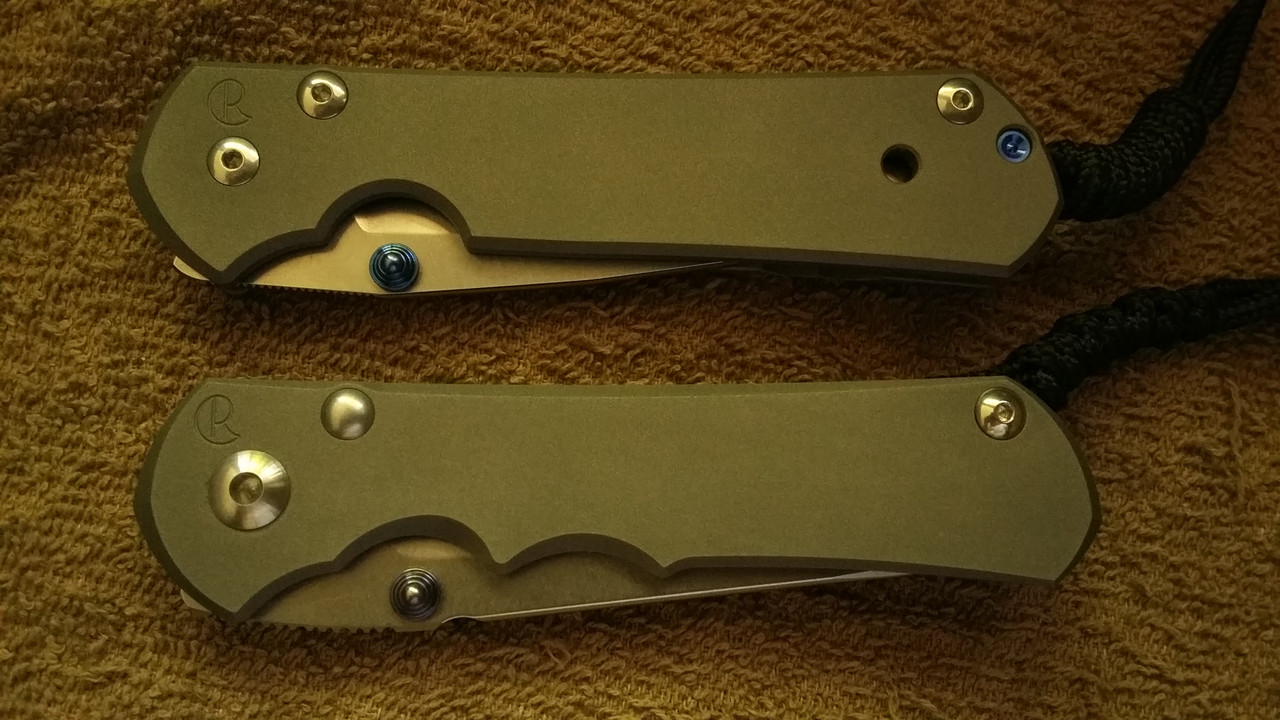 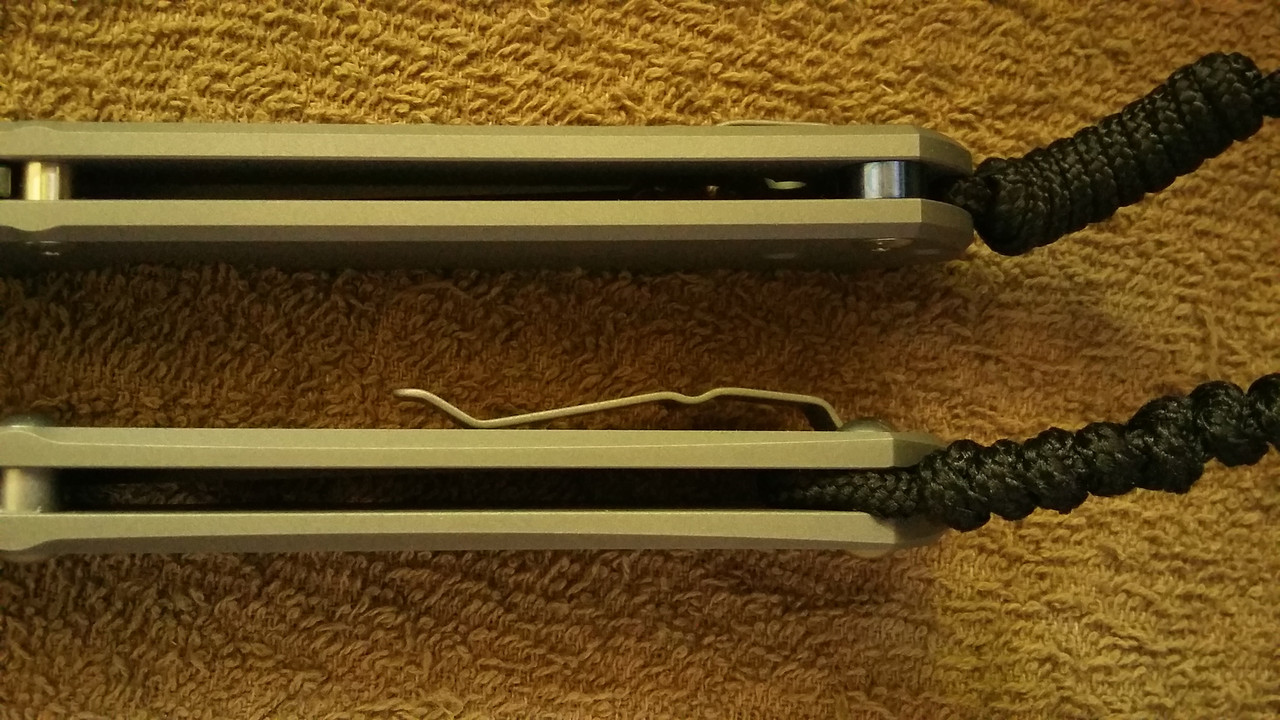 Given the sandblasted scales, and current stonewashed blade, a very monochromatic knife, the Sebenza blue touches at front and rear a welcome touch. Aesthetically, it seems to lose something with the monolithic simpler threaded spacer. 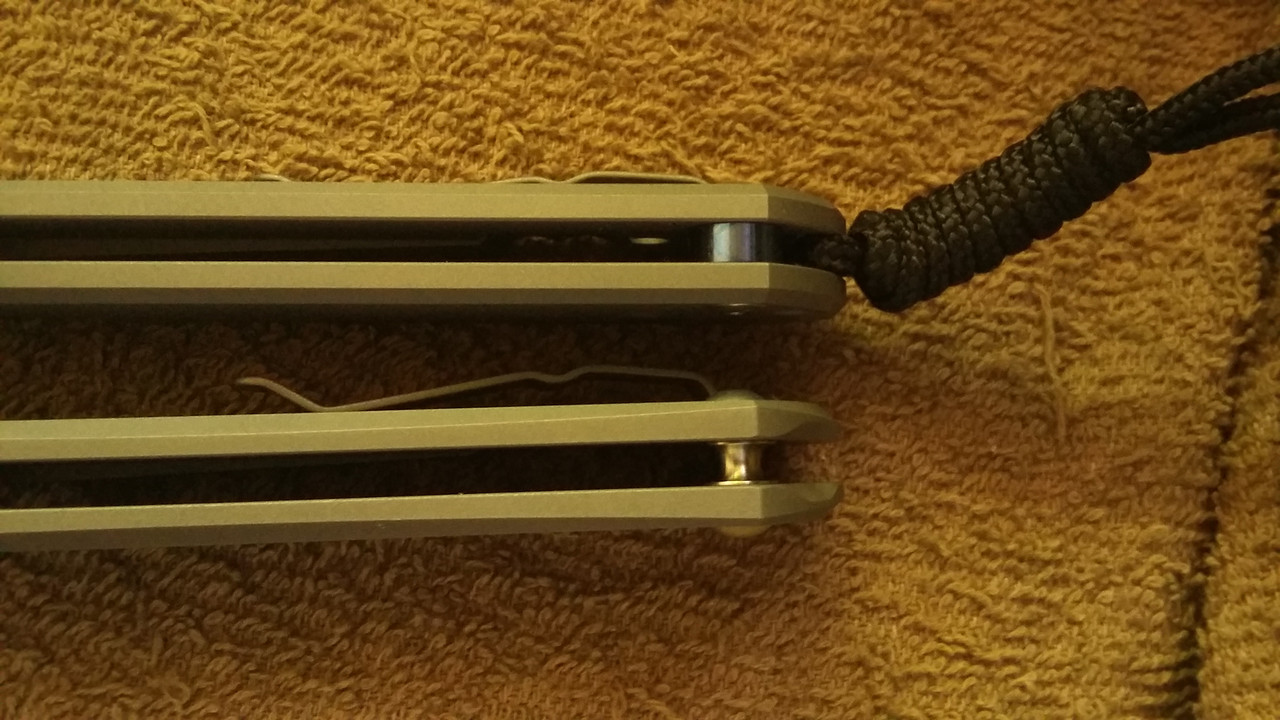 Highlighting the above mentioned access to locking bar. I find the finger grooves well shaped, but, from a marketing standpoint, grooves can also eliminate half the prospective buyers simply due to mismatch. 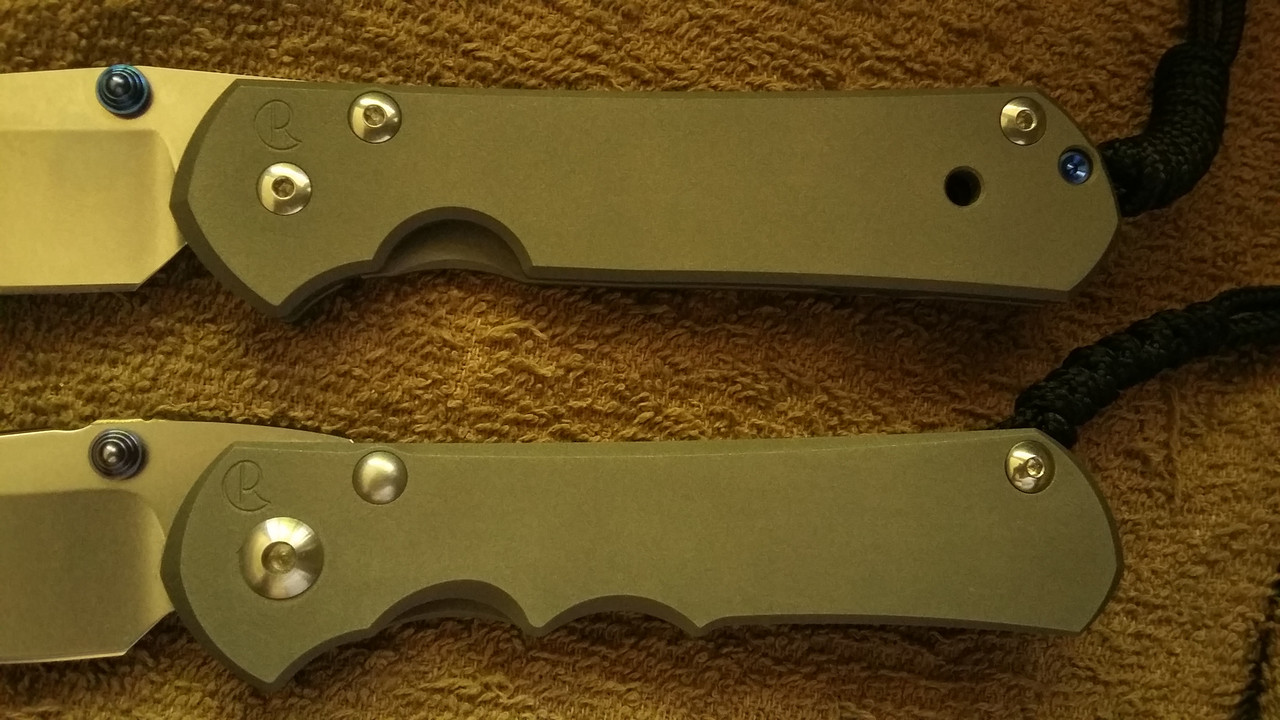 The Inkosi features fixed larger diameter, non-rotating thrust bearing washers which butt against stop pin, making assembly/reassembly less fiddly. 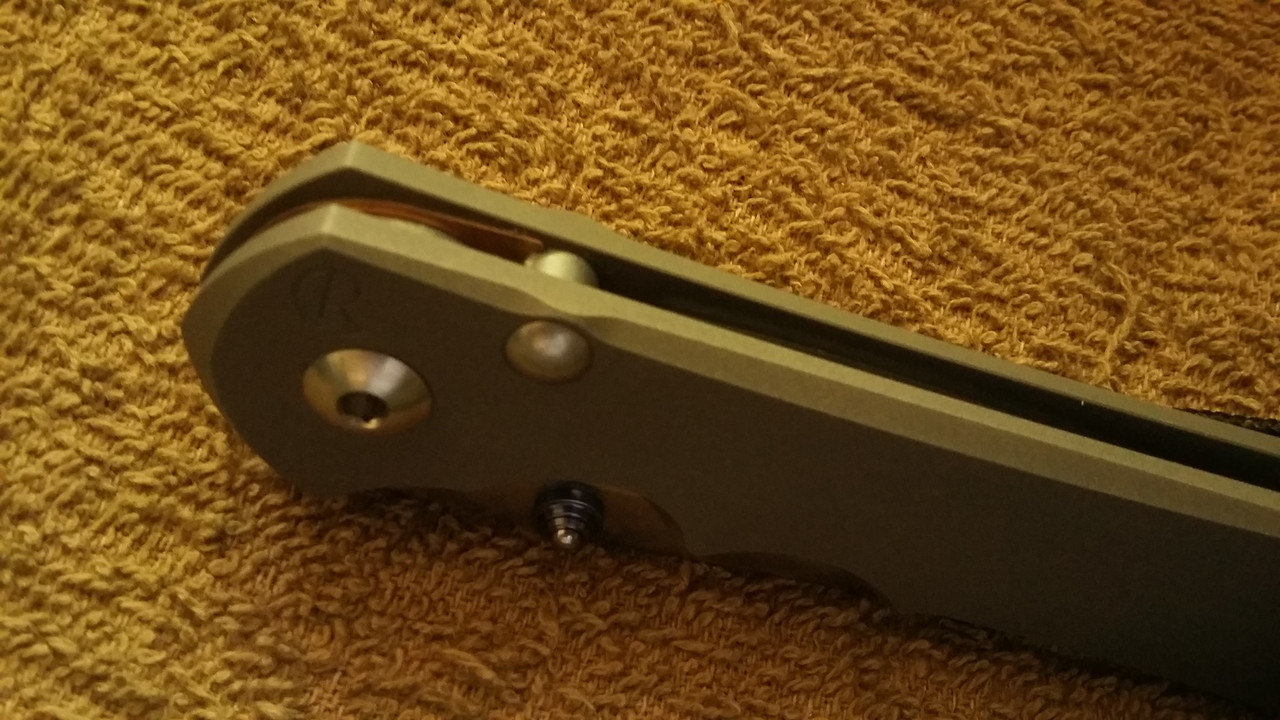 I have no clue as to notch in heavier Inkosi blade. Assumption it being to be held by tooling, just as famous/infamous Sebenza scale hole is from blanks drilled and stacked on a mandrel for exterior circumference initial shape cutting (something obviously licked on the new frames). My closing comments might be only a question, in that, yes, the Sebenza is getting a bit long in the tooth, and dated. Dated from the standpoint of more massive construction, running through entire knife world, thicker locks, thicker blades, larger pivots and stops, thicker edges and tips, swoopier ergonomics, simpler construction needing less precise tolerances, fancy bushings, etc.. But, is trying to cram all of that into a standard large Sebenza shaped handle the answer? Is it even really needed? Perhaps, instead, an all new knife incorporating all of that? And getting external feedback (from outsiders, different observations from not as close to the center), before going full tilt production? Again, no denying they nailed a stronger Sebenza sized knife. As far as successor goes, will let market be the judge of that. It IS a big tough folder, and better than many. 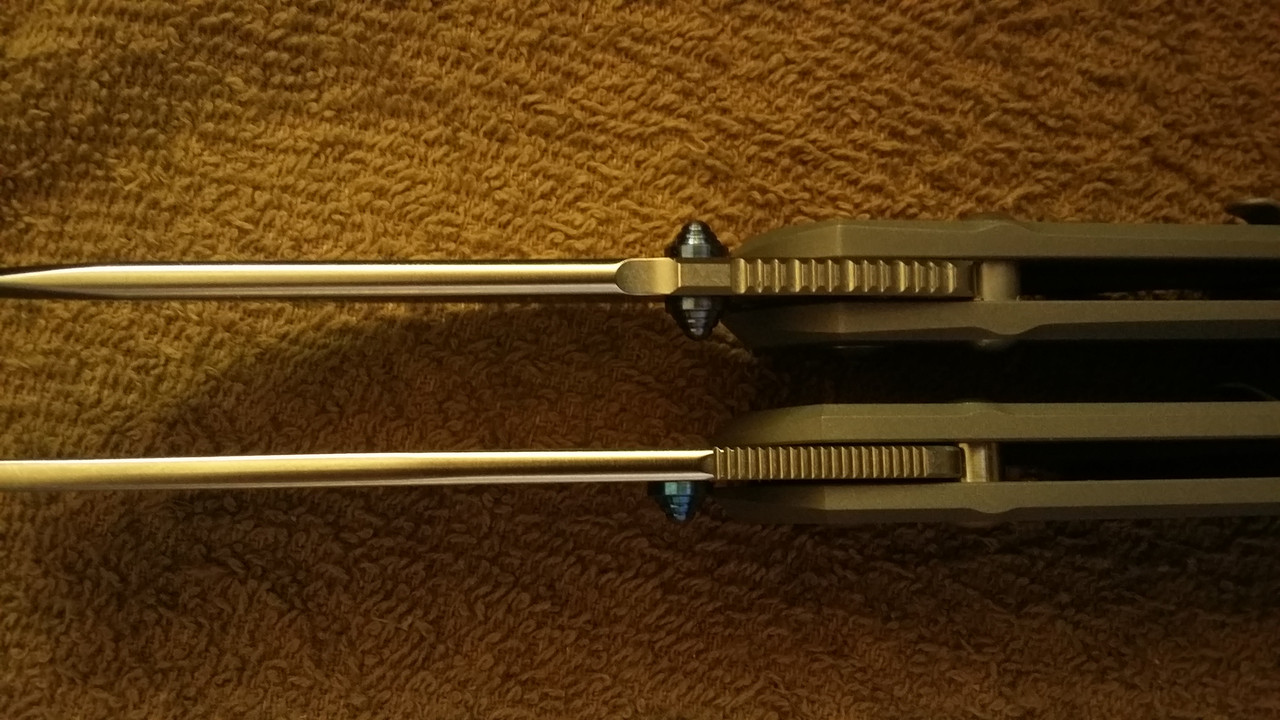 (maybe I should instigate a media and marketing storm with hashtags, tweets, instagrammys or whatever, convince everybody to run go buy a Sebenza and NOW, get Fox News involved, and see what becomes of the Inkosi?.....or.....I could munch on a bag of Chile Cheese Fritos?............Fritos.)
Edited by Lofty (05/11/18 10:35 PM)
_________________________
Cadent a latere tuo mille, et decem millia a dextris tuis;
ad te autem non appropinquabit.
|
|
Top
|
|
|
|
#171097 - 05/11/18 05:39 PM
 Re: The Big Tough Folder...
[Re: pappy19]
Re: The Big Tough Folder...
[Re: pappy19]
|

Knife Enthusiast

Registered: 09/14/05
Posts: 1806
Loc: The Desert Southwest
|
Great posts and very informative. My EDC is a large Sebenza. Pap Agreed--for quite a while, my EDC was a large Sebenza. About a year ago, I moved to a small Inkosi, and like it very much.
------ 
_________________________
-Steve
RKCC CM-066
RKS #258
|
|
Top
|
|
|
|
#171098 - 05/11/18 06:26 PM
 Re: The Big Tough Folder...
[Re: Holzinger258]
Re: The Big Tough Folder...
[Re: Holzinger258]
|

Knife Enthusiast
Registered: 02/06/16
Posts: 656
|
The small Inkosi is a really great knife, a smaller than small Sebenza EDC for folk, and yet stronger, really hitting on something new. As with the smaller Hinderers, really tough big little knife, capable of a suprising amount of heavy lifting. Yes, not unnoticed is the cool older Sebenza Regular, pre-dating the Classic (no handle jimping and ran concurrent with regular in answer to complaints) and its/their successor, the 21,... the Regular pretty much the second major variation, I think? If someone wants to call tweaks to blade and handle profiles and beveling styles major variations to something otherwise essentially unchanged over a quarter of a century, (which sorta spells c-l-a-s-s-i-c, to me, if I kould spell). 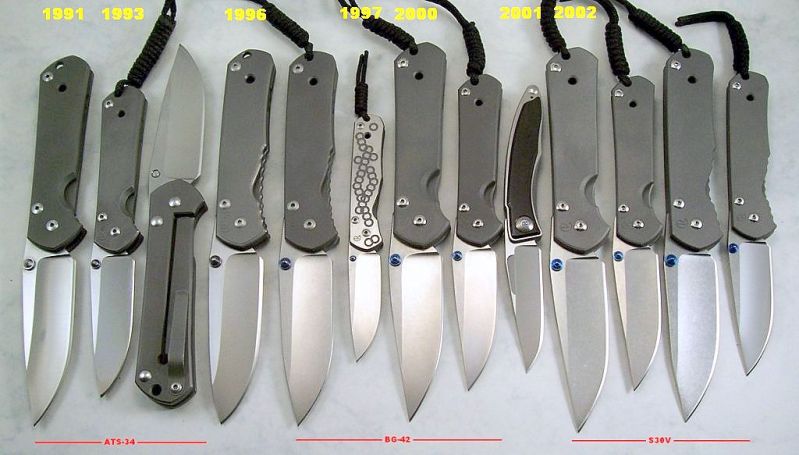 Now, where did I put that bag of Fritos? A forgotten damascus scratching/performance PS....meant to give folk pondering the damascus premium cost an idea as to how it handles scratches from use. Most here are familiar with the bright little spiderweb scratches on their Randall or whatever blade grinds, sparkling only at certain light levels and angles. If you applied those same type things to a thinning but intact, mottled parkerize, that is what you have with the damascus, and them running through a WWI zigzag/razzle-dazzle camo of light and dark, which also show best in certain light strength and angles, while blurring in others. In short, it ages gracefully. There also is a slight amount more of drag in cuts, but only noticeable at all on certain substances, and nothing objectionable unless you insist on a laser beam for all things, all the time, and good luck with that. Otherwise, the damascus same as the mono-steel, and a veritable potato peeler when carving green wood. As a post script to all the raving over the 21 and picking the Inkosi to death, as someone primed and ready to slam anything new, well... all quite wonderful, excepting that simply would not be the case. When I saw the Inkosi, knew only about heavier blade, luuuuved the sheepsfoot, and noticed the beefed up pivot and stop, I snapped up one as fast as one could be tracked down, fully expecting my lighter 21s to be permanently retired, and me have a near unbreakable Sebenza. Which turned out to be true, but, at a far greater cost to the original design elegance than I ever expected.
Edited by Lofty (05/12/18 01:07 AM)
_________________________
Cadent a latere tuo mille, et decem millia a dextris tuis;
ad te autem non appropinquabit.
|
|
Top
|
|
|
|
#171107 - 05/12/18 11:47 AM
 Re: The Big Tough Folder...
[Re: Lofty]
Re: The Big Tough Folder...
[Re: Lofty]
|

Knife Enthusiast
Registered: 02/06/16
Posts: 656
|
The previous postings as to complexity of the 21 design actually still managed to skip several aspects of the perfection Chris Reeve was originally shooting for in his knife.
Getting back to the perfectly parallel side flats of the handle, perfectly gapped by precision spacer bushings. He wanted those for a reason. If you take two parallel lines, a certain space apart, you can insert a slightly smaller rectangle between them, with almost zero clearance.
When you bend the lines together at one end, as a clamping pivot screw will do, you introduce slop and uneven wear, loose behind the screw, and tightest up front, and add binding at the very front. Most folk have seen this on knives able to be disassembled, the heavier arc of wear over only half the blade. Which will cause looseness to develop twice as fast over half the area. Mr. Reeve was doing everything he could, to make the perfect folding knife. With the Sebenza, the screw runs down freely until it bottoms in hole whereupon almost as hitting a brick wall, there is so little play in system taken up by any flexing. The pivot screw has only two positions, snug or snugger, otherwise the screw is loose, threads not being stretched for locking, and vibrates free of own accord.
Another aspect are his spoked/slotted/perforated thrust bearing washers (think wagon wheel). They have reduced surface contact with handle slabs and with knife blade. As mentioned prior, free to rotate between blade and slabs. There is some talk, but sounds plausible, that since these are free to slowly work their way around, that they act as surface scrapers, piling up lube ahead of leading edge of spokes, and applying to the blade.
The Inkosi even larger diameter but even more radically spoked washers, simply sit there. Same reduced surface contact area, perhaps even less area, but not even going there. There is also some talk about them, completely implausible, that they still act as "lube pockets", implausible because any lube down in the spoke recesses of the stamped/lased washers, once scraped flush, is just going to sit there.
With both types, they would certainly act as trash dumps, allowing fine particulate matter to be scraped from blade/washer surface, and collect in those little hollows between the spokes.
There is a luxurious amount of precision in the 21, issues dealt with via over the top precision, where everyone else solves same unequal wear problems by simply changing washers more often. They are, after all, a consumable item, and why you will not hear me weigh in on interminable teflon vs phosphor bronze washer arguments, them being both disposable and interchangeable. Reeve, unlike Hinderer, will not sell you a pack, simply because they require fitting, the tolerances are so close. Same with the pivot bushing on the 21 blade. But, anyone can trot out and buy standard washers of proper ID/OD and near thickness, and give them a rub until they fit, in a pinch.
It is a precision machine, and why the premium, at least, until late new knives and strange price games with older. But, you still get what you pay for, even if now paying more. Same as with older internal combustion engines, far more (theoretically, at least) replaceable/rebuildable parts/surfaces subject to wear. A luxury item, where one pays for meticulous excess, and receives it. Which is altogether different than the common modern trend of paying more for nothing aside from conspicuous consumption bragging rights.
It is still a grand big tough folder. If I had to currently nail down "EDC", somewhat over the top would be the big Hinderer, the Spyderco PacSalt pocket chain saw for when things need to be ripped and NOW, the G43, and the carbon fiber 21, along with the ever present SAK or Pathfinder with a screwdriver blade. Normally would be approaching weight/bulk overload IWB, but the carbon fiber is so light and flat, it dodges being the straw that broke this aging man's back, and lets me have a REALLY sharp large knife with me. Will be honest and say the REALLY sharp knife not needed near as much as the other two on a daily basis, but, nice to have. When looser warm weather clothing hits, as in now, a larger fixed blade over the Hinderer, and things open up a bit as for choices in room and access, given fixed blade goes to left side, often under belt rather than IWB (makes a difference, that), and all sorts of room for the relatively dinky PacSalt and 21. Of all, the PacSalt chainsaw, and the SAK with screwdriver blade and plain blade are ALWAYS there. Never leave home without it, right, Karl?
Edited by Lofty (05/12/18 01:39 PM)
_________________________
Cadent a latere tuo mille, et decem millia a dextris tuis;
ad te autem non appropinquabit.
|
|
Top
|
|
|
|
#171109 - 05/12/18 02:23 PM
 Re: The Big Tough Folder...
[Re: Lofty]
Re: The Big Tough Folder...
[Re: Lofty]
|

Knife Enthusiast
Registered: 02/06/16
Posts: 656
|
A short essay as to why the 25% lighter, piano wood feel, carbon fiber, and tougher damascus, simply are great from the aesthetic end, on pulling a Sebenza together. (Curiously, it also makes the hi-tech but simple Reeve appear as something simple but nice from 200 yrs ago, and could likely slip it in such a dated display with 90% plus of viewers never noting the difference.) And also the neat quirks of stainless damascus and light/angles, from shimmer to stark.  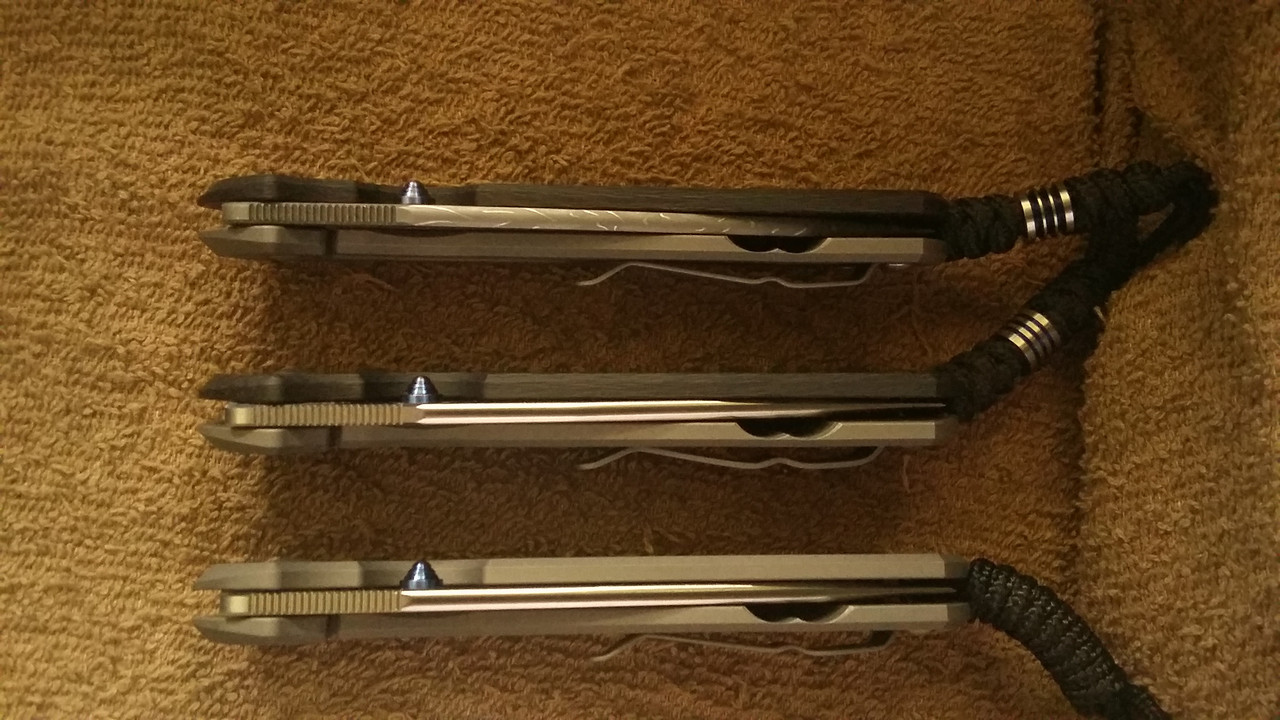   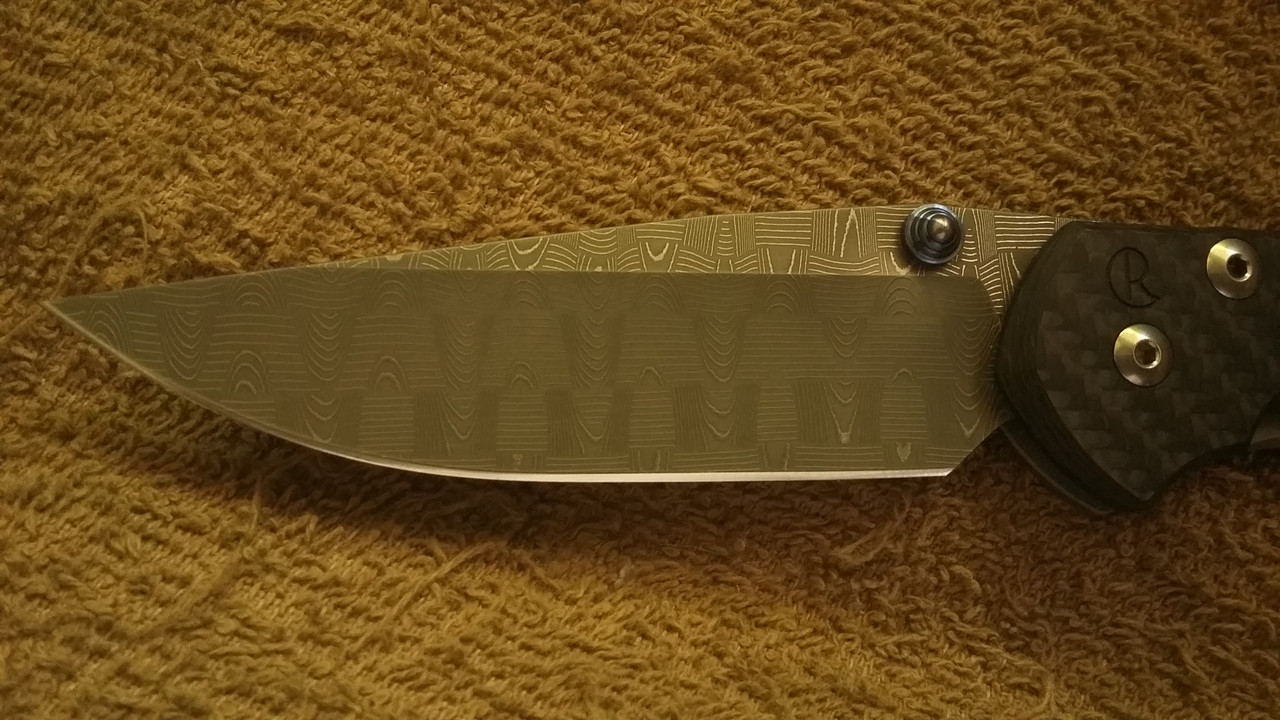 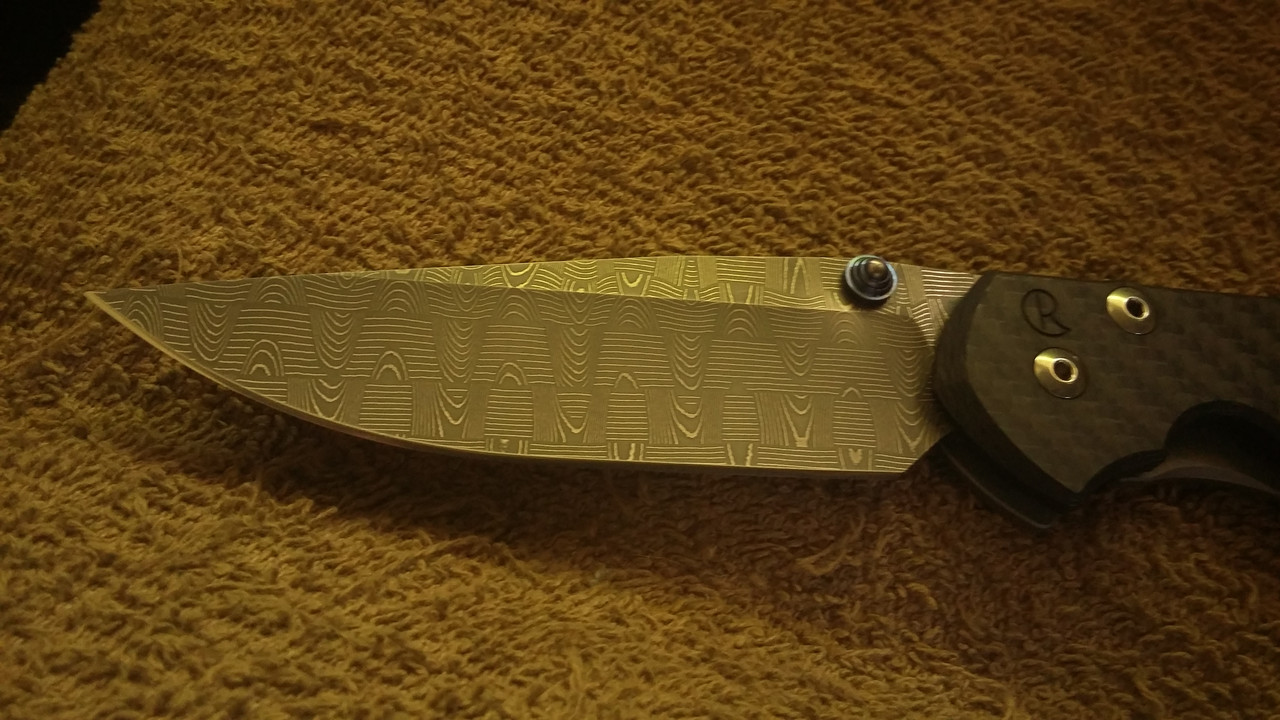 (Goes to show also not all carbon fiber cloth created equal, as for aerospace grade weave, and likewise as to voids in some laminates, luckily no voids in this middle 2yr older version. Look before you buy, or make sure of return privilege if not happy, and smoke it over good, from ANYbody.) Absolute unrelated Reeve trivia, brought only to mind by "smoke it over" written above. Perhaps already mentioned, bears repeating anyhow, but titanium scales are date coded, A-D for quarter, and then year, such as D-17. Mismatch from factory is common enough to be unremarkable, but huge mismatch indicating a Frankenreeve. Locks/blades/bushings/pivots a matched set, so take care if shopping used. Should not be a wobbly flicker, not in the design at all.
Edited by Lofty (05/12/18 10:44 PM)
_________________________
Cadent a latere tuo mille, et decem millia a dextris tuis;
ad te autem non appropinquabit.
|
|
Top
|
|
|
|
#171112 - 05/12/18 05:04 PM
 Re: The Big Tough Folder...
[Re: Lofty]
Re: The Big Tough Folder...
[Re: Lofty]
|

Knife Enthusiast
Registered: 03/20/06
Posts: 1857
|
Lofty-- Reading your posts led to me pulling out my Ed Fowler knife to share a photo of the 4-inch blade with you and others. You probably have read Ed's information online about the steel and his methods for making the best blade that he can turn out. My thought, which must not be original, is: Wonder how to get Ed's performance into a Heavy Duty Folder? I have not followed him closely enough to have read anywhere that this has been done or attempted, but if I get to talk to him at the Blade Show I will ask him about it. "If" the photo comes through here, you will see the grain patterns in the blade. And if you want to read Ed's information online it should be at this link that I found in my files: http://www.edfowler.com/index.phpLarry
------ 
_________________________
Larry W. Williams
RKCC #CM-041
ABKA #046
RKS #1246
|
|
Top
|
|
|
|
#171114 - 05/12/18 06:50 PM
 Re: The Big Tough Folder...
[Re: LarryWW1246]
Re: The Big Tough Folder...
[Re: LarryWW1246]
|

Knife Enthusiast
Registered: 02/06/16
Posts: 656
|
I have often wished the same, myself. I followed Ed back in the day, so to speak, along with many others, back before even an ABS, and why my most trustworthy blades, the ONE I would grab, would be an ABS MS knife from one of several makers, any would get me through anything, or I would be the thing which failed. And there are many never heard of, who perhaps are even better, as they are too busy making knives, rather than writing, promoting, running for office, or trying to hit it big, etc etc.
One problem with that concept always bugged me. Nobody yet has come out with a lock worthy of such a blade. The Hinderer is close in 3 out of 4 axis. But that closing axis is the killer.
Every popular lock is sprung closed, or in the case of liner/frame locks, IS the spring. Any will bounce under shock, leading to anywhere between all and none of lock surface engaging, lesser surface contacts under shock causing severe deformation and failure far sooner. Great examples of such being spine whacks with most any plain liner or integral can bounce/squirt one unlocked, likewise lockbacks can see-saw madly while buzzing from shock, and even the highly regarded Axis lock disengaged with a moderate blow to pommel.
The all lose to inertia, as enough inertia will compress a spring.
I have puzzled over this and have come up with several workable solid locks, using suchlike a 1/4" horizontal dowel as used on stop studs simply camming down into track on back of blade of an out the front slider of close tolerance. The out the front takes care of all but straight back failure right out of the starting gate, being surrounded by handle (strong enough handle). But am not the machinist to make it, nor driven enough to more than armchair general such things.
But a fine blade would really be a waste if handle and lock not up to what such a blade could do, otherwise a Rolls winged victory on an Isuzu.
oh...and simple congratulations on owning a blade by Ed. It would be hard to imagine better and it be steel. Dan Maragni has attacked the same ideas of superlative, even defining them (as they all must do, just for a target), via a completely different route in inducing such transformations of molecular structure via various heat treating, soaking, quenching cycles including molten salt baths, interrupting at one state, and taking the steel an entirely different direction than it would naturally. Some of the simple, but exceedingly pure and fine grained steels to come out of Sweden and Germany have been another approach to the same thing. What defines them all is, what are you expecting it to do when you are finished? A literal finest edge possible razor/scalpel steel will not make the best all day dirty hide stripper, and the best hide stripper a poor wood or bone splitter. I recall Rick Hinderer relating his choices of steel and unpolished edging, with a personal account of years ago wanting to make the ultimate sharp knife, sharpest ever made, truly fine enough to split a human hair, and he succeeded, using a microscope, even. The thing was, that same ultimate edge was terrible on most everything else. The steel composition lacked protruding carbides at the edge, and the edge lacked physical tooth to cut anything else.
Back to ultimate forged blade for ultimate tough folder, until we get a better handle and lock, we may have the best blades we deserve. As an aside, I cannot help but chuckle in thinking what some of the best bladesmiths might turn out for a folder, many of them may be among the best bladesmiths of all time, but engineer or mechanism designer they ain't...I am picturing a solid maple wood handle and wire inlay with bent nail through blade, even now, called The Early American.
Edited by Lofty (05/13/18 01:44 AM)
_________________________
Cadent a latere tuo mille, et decem millia a dextris tuis;
ad te autem non appropinquabit.
|
|
Top
|
|
|
|
#171116 - 05/12/18 07:42 PM
 Re: The Big Tough Folder...
[Re: Lofty]
Re: The Big Tough Folder...
[Re: Lofty]
|

Knife Enthusiast
Registered: 02/06/16
Posts: 656
|
Truth in advertising statement regarding carbon fiber lay-up, lest someone try to hunt me down, later, what with all my rah rah over the Reeve.
It is incredibly light, stiff, and strong, but one runs into the same thing as the wondersteels. It is so hard and stiff as to seem indestructible, until its yield point is reached, whereupon when it goes, it goes. Meanwhile the titanium does the normal steel thing and just springs or takes a set. With carbon fiber, you would just swear it was balsa wood cracking when it lets go. If that ever happens, stay the heck away from protruding fibers, they make a cactus look like a nerf ball, are glass brittle and break at the touch, whether going in, or, trying to get them out.
Not that I lose any sleep over it, as talking stresses where one would KNOW something is gonna give, whether handle or blade. At the level of, "hmmm, I can leave it all titanium and for sure break the blade doing this," to, "hmmm, I can use the carbon fiber for this, and see which breaks first, the blade or handle." For any other use, any, it would be plenty strong, including hardest and most energetic frenzied cutting/carving. But with so much carbon fiber in use today, especially open framed folding knives, folk DO need to understand the stuff breaks, and ugly when it does.
Edited by Lofty (05/13/18 03:13 PM)
_________________________
Cadent a latere tuo mille, et decem millia a dextris tuis;
ad te autem non appropinquabit.
|
|
Top
|
|
|
|
|
|



